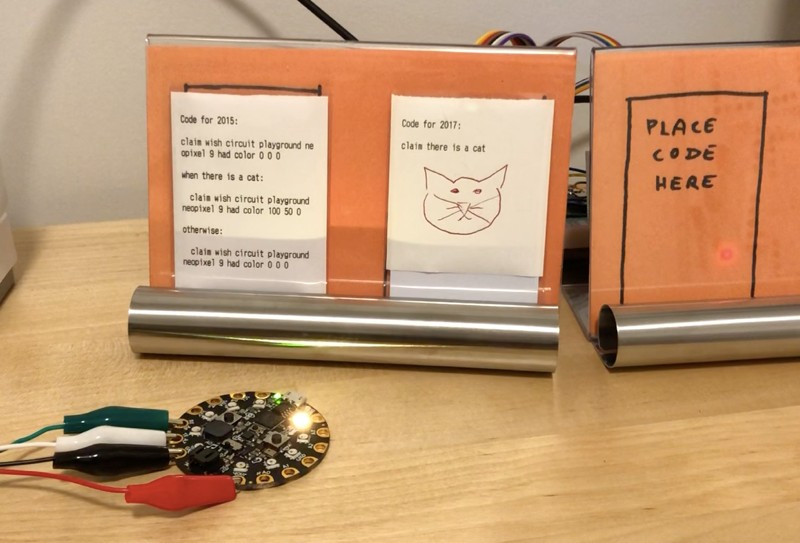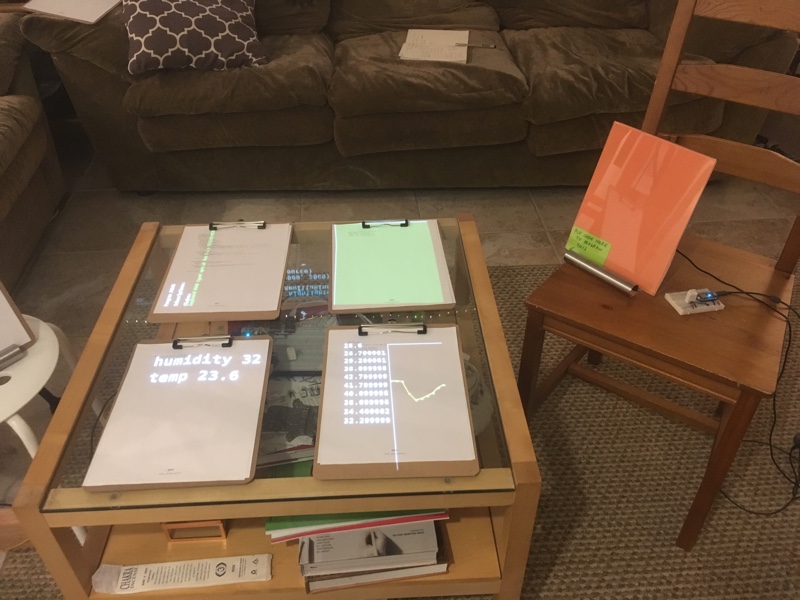Gallery
CircuitPython Editor
2021-04-25
Integrating electronics into a programmable space in a way that is good for multiple people casually making changes.
See More →
Musical Posters
2020-08-29
Leaning into the aesthetic of hanging posters of your favorite bands on the wall!
What if you could hear the band just by pointing at it?
Based on the "Laser Regions" demo from 2019.
See More →
Voice Assistant Reimagined
2020-07-15
A voice assistant that is made personal and valuable to people in the room by customizing it with programmable
cards.
See More →
Dangling String
2020-04-03
A recreation of "Dangling String" by Natalie Jeremijenko that slowly twirls and then spins every 20 minutes.
Experimenting with beautiful and functional devices that are meant to calmly use periphery senses.
See More →
Calendar as input/output
2020-03-25
A paper calendar hanging on the wall used as an input and output to the programmable room.
A projecting desk lamp is used to augment the calendar and a laser pointer is used to select dates.
See More →
Turtlebot Simulation
2020-03-10
RFID Card programs are used as inputs to a turtlebot simulation.
See More →
AR Desk Lamp
2020-02-16
Desk lamp with projector, camera, and raspberry pi inside is used to display graphics on a desk.
See More →

Programs as RFID Cards
2020-02-11
Programs in the programmable space are represented by RFID Cards with program source code printed on receipt
paper.
See More →
I’ve wanted to recreate the “Animation World” from @TablaViva for almost two years now and I finally got around to it. So fun! pic.twitter.com/j5WAKgkA45
— Jacob Haip (@jhaip) September 26, 2019
Drawn Animations
2019-09-26
A fun and informal way to make short hand-drawn animations.
One program claims each frame to the room and then another program draws the animation.
See More →
Laser Regions
2019-09-08
Parts of the wall are traced using a laser pointer and given a name in the programmable space.
These regions can be used to make things like a map that shows nearby restaurants when you point at it.
See More →
Non-Textual Robot Programming
2019-09-08
An experiment in programming in the programmable space without editing text.
Lego blocks with symbols on them are used to control the movement of a robot.
See More
→
Spatial Data Flow
2019-09-08
Using the spatial arrangement of papers to do "visual programming" where data flows and is
transformed/visualized by each program.
See More →
Microcontrollers Programming
2019-03-17
Code is transferred to a microcontroller by physically putting the code next to the microcontroller.
Making it more understandable what the microcontroller is doing and what code it is running.
See More →

Programs as RFID Clipboards
2019-03-17
Programs represented physically in the room by clipboards with RFID cards taped to the back.
The clipboards hold the program's printed source code so people in the room can understand what the program
does.
See More →

Fixed Grid of Programs
2019-01-20
An early experiment that avoided making program sensing code by having a fixed grid of programs that were
always running.
Proved programs could run separately, but it showed programs needed to be made physical in the future to use
the full scale of the room.
See More →